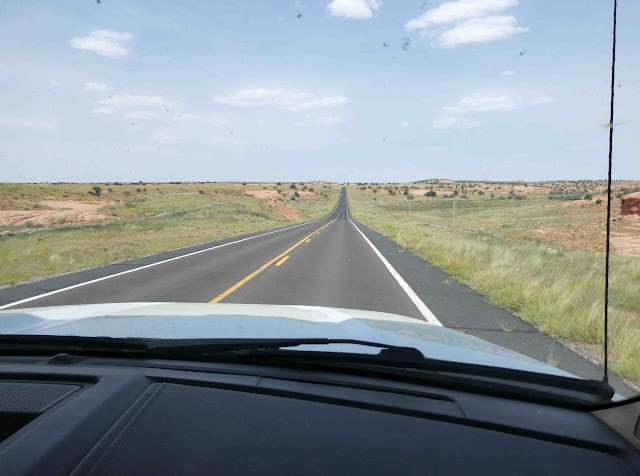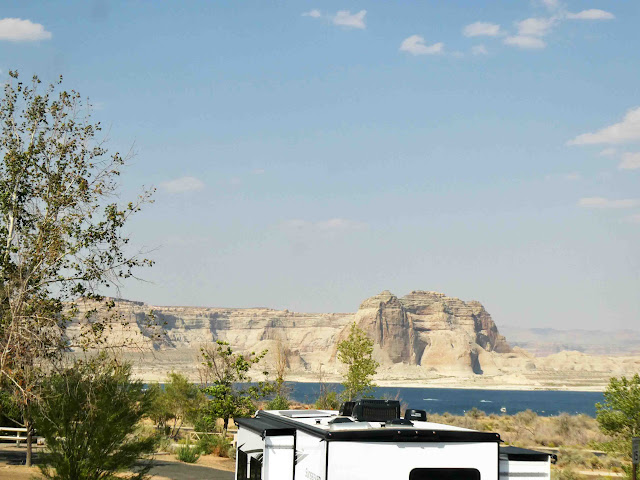Good morning, my friends. We find ourselves nearly 300 miles down the road and in a brand new state...not new to us, of course, but new to this trip. Leaving Moab, we drove through deep rocky and red canyons.
On the morning of June 10, 2009, sixteen Blanding residents were arrested in more than a dozen raids performed by federal agents and indicted as part of an undercover investigation of violations of the Archeological Resources Protection Act. Eight others around the Four Corners region were also indicted. The raid was the largest undercover sting of its kind in the country. The raid was the conclusion of a two-year investigation by FBI and BLM agents code-named "Cerberus Action" in which an undercover agent was able to purchase 256 artifacts for $335,685.
It was a small, fenced settlement from the 19th century in southeast Utah in the United States, an area that was uninhabited until that time. The settlement [came] at the end of the 6-month San Juan Expedition. The route that these American pioneers took on their way to establish the settlement is called the Hole in the Rock Trail. The journey and the route are an integral part of the act of settling in Bluff Fort.
* * * * *
In a corner of the fort, the Bluff pioneers established a cooperative trading post. The cooperative sold goods and supplies to the people of the settlement and traded with the Navajo. Soon the store began to declare dividends. The pioneers bought wool from the Navajos, leathers and blankets and transported these goods to Durango, Colorado for sale. On the return trip from Durango, they brought in other cargoes which were sold at Bluff Port, thus making a nice profit. The profits from the co-op provided the means for the pioneers to stay on site and helped to start the thriving cattle business years later.
When the settlement was founded, there were 258 people in Bluff Fort: 43 men over 19; 29 women over the same age; 120 children under 19, including babies. They lived in 66 huts, owned 83 carriages, about 200 head of cattle and about 1,800 other animals.
Continuing on, we crossed the border into Arizona.
Kayenta (in Navajo: Tó Dínéeshzheeʼ meaning "Fingers of Water" because of how water runs down the rocks when it rains) is a U.S. town which is part of the Navajo Nation and is in Navajo County, Arizona, United States. Established November 13, 1986, the Kayenta Township is unique in being the only "township" existing under the laws of the Navajo Nation.
We passed through 15 miles where we were warned to watch out for wild horses on the road. Free range, in other words. We often see signs warning of free range cattle. Being warned about horses was something new. Indeed, we saw a few as we drove along.
Page was founded in 1957 as a housing community for workers and their families during the construction of nearby Glen Canyon Dam on the Colorado River. Its 17-square-mile (44 km2) site was obtained in a land exchange with the Navajo Nation. The city is perched atop Manson Mesa at an elevation of 4,300 feet (1,300 m) above sea level and 600 feet (180 m) above Lake Powell.The city was originally called Government Camp, but was later named for John C. Page, commissioner of the Bureau of Reclamation, 1936–1943.After the dam was completed in 1966, Page officially incorporated as a town on March 1, 1975. The city grew steadily to today's population over 7,000. Because of the new roads and bridge built for use during construction, it has become the gateway to the Glen Canyon National Recreation Area and Lake Powell, attracting more than 3 million visitors per year.

































6 comments:
Never give up; for even rivers someday wash dams away. ~ Arthur Golden
Enjoy the warmth it is cool here. We got over a 1/2 inch of rain yesterday and could get another little bit today. Tomorrow should be dry then rain on Saturday. It feels like fall is here and the leaves are beginning to show a little color but when you return home it should be about the time they turn I earnest. I am so glad that the issue with the air conditioner was just a connection. Ha, just, but I bet it took some time to find it. Good thing your hubby is handy.
We got our National Parks geezer pass just a couple of weeks ago when we drove through the Badlands on our mini vacation. I would like to make use of it again later this fall - somewhere west. But that might be wishful thinking. LOL Such amazing rock formations you've been seeing on this trip.
I am sorry that I have fallen off the 'good commenter' wagon and gotten sadly behind. Blame my crazy life the last week and a bit (nothing bad, just a lot of 'stuff'). So....rather than inundate you with comments, I will jump in here to tell you that I really have been traveling along with you but time to comment has been non-existent. As always I enjoy seeing your pictures and reading your travel notes. Hopefully I can regain my commenting stripes now.
Such interesting countryside you saw during the drive. So glad the air conditioning was an easy fix, that's too hot to not have air.
I was wondering what the temps were there - sure glad the AC was a quick fix!
Post a Comment